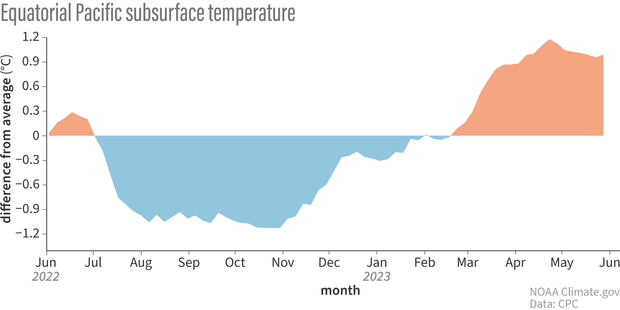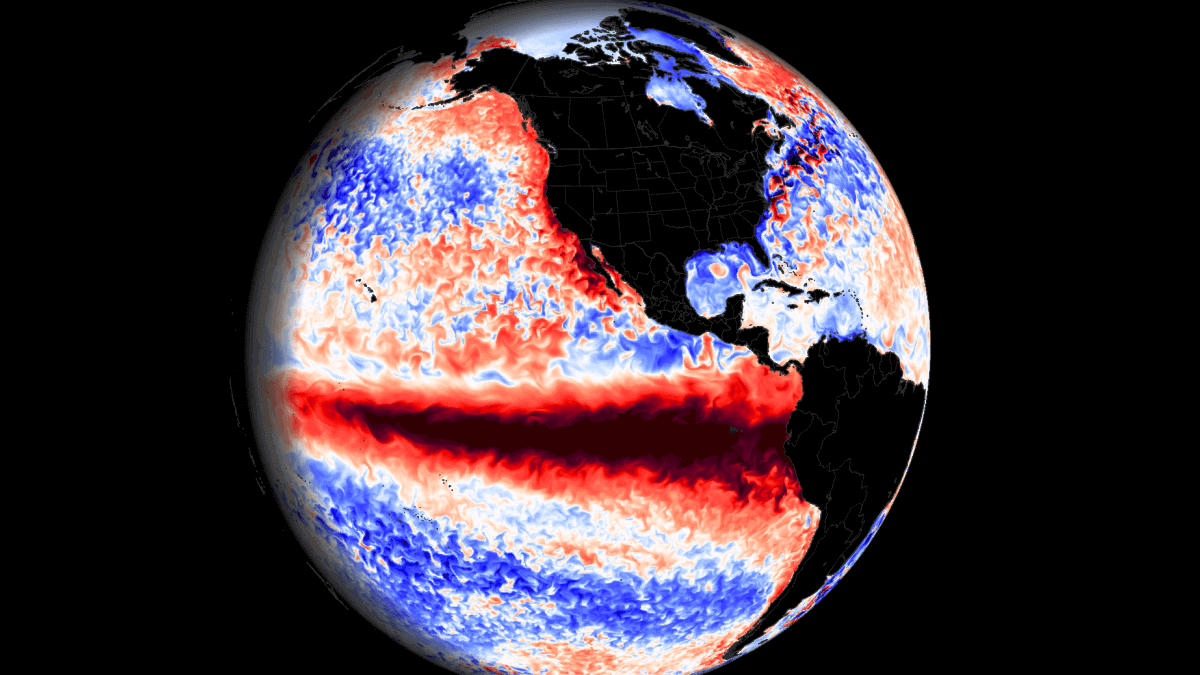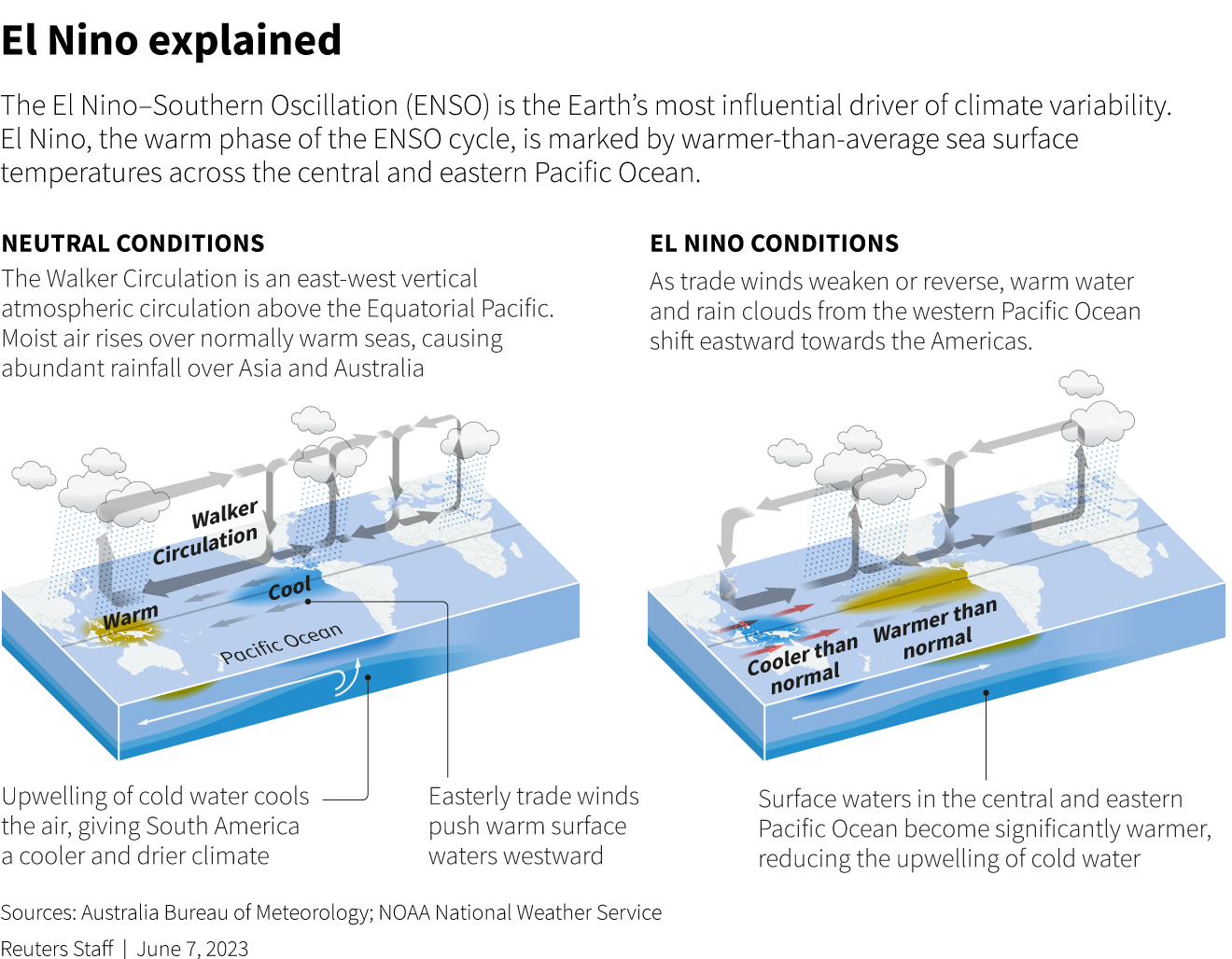El Nino, a climate pattern that describes the unusual warming of surface waters in the eastern tropical Pacific Ocean, is a naturally occurring phenomenon that significantly influences weather patterns, ocean conditions, and marine fisheries worldwide.
This pattern is part of a larger phenomenon called the El Niño-Southern Oscillation (ENSO), which also includes La Niña, the “cool phase” that describes the unusual cooling of the region’s surface waters. El Nino events typically bring a quieter Atlantic hurricane season but more hurricane activity in the Pacific.
In 2023, the world is bracing for an El Nino event that experts fear could be particularly severe. This article will delve into the causes of El Niño and explore the projected impacts of the 2023 event on different countries.
Causes of El Nino
El Nino is born out of unusually warm waters in the eastern Pacific. This warming occurs when the trade winds blowing east-to-west along the equatorial Pacific slow down or reverse due to changing air pressure. The exact trigger for this cycle remains a subject of scientific exploration.

The weakening of the trade winds causes warm western Pacific waters to flow back into the colder central and eastern Pacific basins. This build-up of warm water in the eastern Pacific transfers heat high into the atmosphere through convection, generating thunderstorms. The shift in warm water affects where thunderstorms occur, which is described as the “first atmospheric domino to fall” in the El Niño cycle.
Impact of El Nino on Global Weather
The redistribution of warm water and subsequent shift in storm activity has profound effects on global weather patterns. It impacts the subtropical jet stream, a fast-flowing air current that moves weather around the globe, pushing its path southward and straightening it out. This results in similar weather being delivered along the same latitudes.

During an El Niño event, the southern United States typically experiences cooler and wetter weather, while parts of the U.S. West and Canada are warmer and drier. Hurricane activity in the Atlantic tends to falter due to changes in the wind, but tropical cyclones in the Pacific get a boost, often moving towards vulnerable islands. In Central and South America, some regions experience heavy rainfall, although the Amazon rainforest tends to suffer from drier conditions. Australia endures extreme heat, drought, and bushfires. On a positive note, El Niño could bring more rain to the Horn of Africa, a region that has suffered from failed rainy seasons in the past.
Impact of the 2023 El Nino Event
The 2023 El Nino event is expected to be particularly severe. Governments worldwide are preparing for extreme weather as this El Niño, coupled with excess warming from climate change, is predicted to result in record-high temperatures. Prior to the onset of this El Niño, the average global sea surface temperature was already higher than any other on record, which could supercharge extreme weather events.

This year’s El Niño could lead to global economic losses of $3 trillion due to extreme weather impacting agricultural production, manufacturing, and promoting disease spread. Vulnerable countries are taking proactive measures. For example, Peru has set aside $1.06 billion to mitigate the impacts of El Niño and climate change, and the Philippines has formed a special government team to handle the predicted fallout, given its risk from cyclones.
El Niño and Climate Change
The relationship between climate change and El Niño remains a complex research question. While climate change is exacerbating the impacts of El Niño, layering heat on top of heat or excess rainfall on top of excess rainfall, it is less clear if climate change is influencing the phenomenon itself. If ocean temperatures are rising uniformly, the basic mechanics behind the El Niño phenomenon would likely stay the same. However, if certain parts of the ocean are warming faster than others, this could influence how El Niño unfolds by amplifying temperature differences.
El Niño is a powerful natural climate phenomenon with global impacts. Its potential to alter weather patterns and intensify extreme weather events makes it a significant concern for countries around the world. The 2023 El Niño event is expected to be particularly intense, leading to substantial global economic losses and challenging environmental conditions. As the world continues to grapple with climate change, understanding and preparing for such phenomena becomes increasingly vital.

The 2023 El Niño underscores the need for comprehensive climate research, mitigation strategies, and international cooperation. While the forces behind El Niño are natural and periodic, the consequences are immediate and far-reaching, affecting everyone from farmers in the American Midwest to fishermen in the Pacific and residents in the typhoon-prone regions of Asia. As we gain a deeper understanding of these climatic events, we can better prepare and adapt, reducing the human and economic costs of these natural climate phenomena.
What you need to know
As of June 2023, an El Niño event has been declared and is underway. It is expected to fuel tropical cyclones in the Pacific, boost rainfall, and increase flood risk in parts of the Americas and elsewhere. The last time a strong El Niño was in full swing, in 2016, the world saw its hottest year on record, and similar record-high temperatures are expected this year.
While it is possible to provide generalized impacts based on geographical location and climate, detailed, country-specific forecasts are best left to meteorologists and climatologists, who have access to the most recent and detailed data.
Here are the potential effects of El Nino on different regions:
- North America: El Niño will bring cooler and wetter weather to the southern United States, while parts of the U.S. West and Canada may experience warmer and drier conditions.
- Asia: Countries like China and Japan could see disruptions to their agricultural sectors due to changes in weather patterns. The same is true for Southeast Asian countries like Thailand, Malaysia, and Indonesia. Extreme heat will hit those countries in 2023.
- Europe: Countries such as France, Spain, Italy, and Germany may see changes in their rainfall patterns and temperatures. Some parts of Europe may experience milder winters during El Niño years, while others could see an increase in stormy weather.
- Australia: This country endures extreme heat, drought, and bushfires during El Niño events.
- South America: Countries like Peru and Argentina could see heavy rainfall, which might lead to increased flood risk.
El Nino tor travelers: Top 10 tips
Given the potential impacts of the 2023 El Niño event, here are some general pieces of advice for travelers planning to visit countries that may be affected:
- Stay Informed: Keep yourself updated about the weather forecasts for your destination. This will help you to make necessary adjustments to your travel plans.
- Travel Insurance: Ensure you have comprehensive travel insurance that covers disruptions due to weather events.
- Emergency Preparedness: Familiarize yourself with the local emergency procedures and services in the area you’ll be visiting. Know the locations of the nearest hospitals, emergency shelters, and other essential services.
- Pack Appropriately: Depending on the forecast, pack suitable clothing and accessories. For example, if heavy rainfall is expected, ensure you have waterproof clothing and shoes.
- Health Precautions: Changes in weather patterns can sometimes lead to a rise in certain diseases, such as mosquito-borne illnesses. Take necessary precautions such as getting recommended vaccines and carrying appropriate medication.
- Respect Local Guidance: If local authorities recommend certain actions, such as evacuating a particular area due to incoming severe weather, make sure to follow their instructions.
- Flexible Itinerary: Keep your travel plans flexible to accommodate potential weather disruptions. This might mean being open to changing your destinations, delaying travels, or extending your stay.
- Stay Connected: Keep your devices charged and consider investing in a local SIM card or international roaming to ensure you can receive updates and reach out to emergency services if necessary.
- Respect Nature: Understand that severe weather can strain local ecosystems. Be respectful of the environment and follow guidelines for responsible tourism.
- Plan for Delays: Severe weather can lead to flight delays or cancellations, and public transport may also be affected. Be prepared for this possibility and allow extra time for travel.
Remember that the impacts of El Niño can be quite varied depending on the specific country and time of year, so it’s important to look at the most recent forecasts and advice for your particular destination and travel dates.





